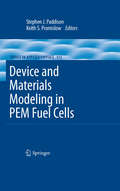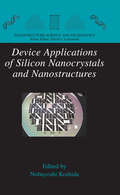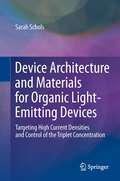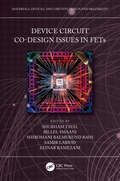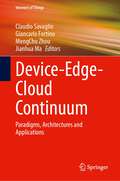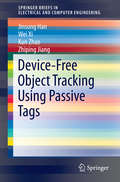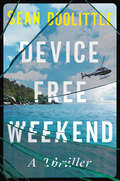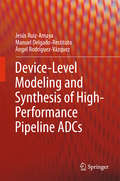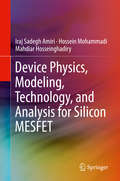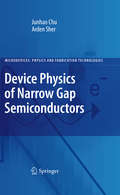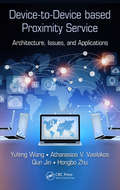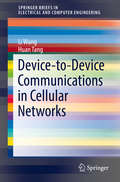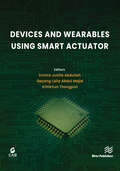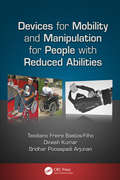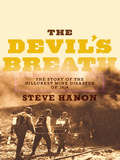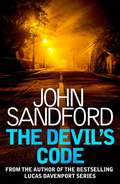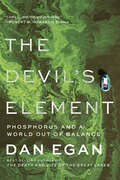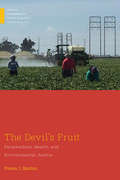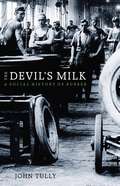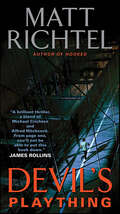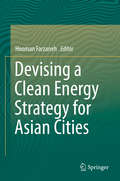- Table View
- List View
Device and Materials Modeling in PEM Fuel Cells
by Stephen J. Paddison Keith S. PromislowThe impact of proton exchange membrane (PEM) fuel cells on energy generation will parallel the impact of the integrated circuit on information technology. The underlying processes in PEM fuel cells have strong ties to energy generation at the mitochondrial level in organic life. The potential applications range from the micron scale to large scale industrial production. Successful integrated of PEM fuel cells into the mass-market will require new materials and a deepening understanding of the balance required to maintain the various operational states. Key areas of development include electrocatalysts for the fuel and air electrodes and membranes exhibiting good proton conductivity under minimal hydration and temperatures between -20 °C to 120 °C. New materials possessing improved properties will emerge as a result of a collaborative effort between experimentalists, engineers, and theorists, the latter doing both device and materials modeling. This book presents a series of contributed articles from scientists who have made a contribution in the modeling of fuel cells from either a device or materials perspective. As fuel cell technologies are an emerging area this book will be of interest to any working in this field. This book will provide a survey (with significant depth) of virtually all the computational and modeling work done in this area.
Device Applications of Silicon Nanocrystals and Nanostructures
by Nobuyoshi KoshidaRecent developments in the technology of silicon nanocrystals and silicon nanostructures, where quantum-size effects are important, are systematically described including examples of device applications. Due to the strong quantum confinement effect, the material properties are freed from the usual indirect- or direct-bandgap regime, and the optical, electrical, thermal, and chemical properties of these nanocrystalline and nanostructured semiconductors are drastically changed from those of bulk silicon. In addition to efficient visible luminescence, various other useful material functions are induced in nanocrystalline silicon and periodic silicon nanostructures. Some novel devices and applications, in fields such as photonics (electroluminescence diode, microcavity, and waveguide), electronics (single-electron device, spin transistor, nonvolatile memory, and ballistic electron emitter), acoustics, and biology, have been developed by the use of these quantum-induced functions in ways different from the conventional scaling principle for ULSI.
Device Architecture and Materials for Organic Light-Emitting Devices
by Sarah ScholsDevice Architecture and Materials for Organic Light-Emitting Devices focuses on the design of new device and material concepts for organic light-emitting devices, thereby targeting high current densities and an improved control of the triplet concentration. A new light-emitting device architecture, the OLED with field-effect electron transport, is demonstrated. This device is a hybrid between a diode and a field-effect transistor. Compared to conventional OLEDs, the metallic cathode is displaced by one to several micrometers from the light-emitting zone, reducing optical absorption losses. The electrons injected by the cathode accumulate at an organic heterojunction and are transported to the light-emission zone by field-effect. High mobilities for charge carriers are achieved in this way, enabling a high current density and a reduced number of charge carriers in the device. Pulsed excitation experiments show that pulses down to 1 µs can be applied to this structure without affecting the light intensity, suggesting that pulsed excitation might be useful to reduce the accumulation of triplets in the device. The combination of all these properties makes the OLED with field-effect electron transport particularly interesting for waveguide devices and future electrically pumped lasers. In addition, triplet-emitter doped organic materials, as well as the use of triplet scavengers in conjugated polymers are investigated.
Device Circuit Co-Design Issues in FETs (Materials, Devices, and Circuits)
by Béatrice HendrichThis book provides an overview of emerging semiconductor devices and their applications in electronic circuits, which form the foundation of electronic devices. Device Circuit Co-Design Issues in FETs provides readers with a better understanding of the ever-growing field of low-power electronic devices and their applications in the wireless, biosensing, and circuit domains. The book brings researchers and engineers from various disciplines of the VLSI domain together to tackle the emerging challenges in the field of engineering and applications of advanced low-power devices in an effort to improve the performance of these technologies. The chapters examine the challenges and scope of FinFET device circuits, 3D FETs, and advanced FET for circuit applications. The book also discusses low-power memory design, neuromorphic computing, and issues related to thermal reliability. The authors provide a good understanding of device physics and circuits, and discuss transistors based on the new channel/dielectric materials and device architectures to achieve low-power dissipation and ultra-high switching speeds to fulfill the requirements of the semiconductor industry. This book is intended for students, researchers, and professionals in the field of semiconductor devices and nanodevices, as well as those working on device-circuit co-design issues.
Device-Edge-Cloud Continuum: Paradigms, Architectures and Applications (Internet of Things)
by Claudio Savaglio Giancarlo Fortino MengChu Zhou Jianhua MaThis book focuses on both theoretical and practical aspects of the “Device-Edge-Cloud continuum”, a development approach aimed at the seamless provision of next-generation cyber-physical services through the dynamic orchestration of heterogeneous computing resources, located at different distances to the user and featured by different peculiarities (high responsiveness, high computing power, etc.). The book specifically explores recent advances in paradigms, architectures, models, and applications for the “Device-Edge-Cloud continuum”, which raises many 'in-the-small' and 'in-the-large' issues involving device programming, system architectures and methods for the development of IoT ecosystem. In this direction, the contributions presented in the book propose original solutions and aim at relevant domains spanning from healthcare to industry, agriculture and transportation.
Device-Free Object Tracking Using Passive Tags
by Jinsong Han Wei Xi Kun Zhao Zhiping JiangThis SpringerBrief examines the use of cheap commercial passive RFID tags to achieve accurate device-free object-tracking. It presents a sensitive detector, named Twins, which uses a pair of adjacent passive tags to detect uncooperative targets (such as intruders). Twins leverages a newly observed phenomenon called critical state that is caused by interference among passive tags. The author expands on the previous object tracking methods, which are mostly device-based, and reveals a new interference model and their extensive experiments for validation. A prototype implementation of the Twins-based intrusion detection scheme with commercial off-the-shelf reader and tags is also covered in this SpringerBrief. Device-Free Object Tracking Using Passive Tags is designed for researchers and professionals interested in smart sensing, localization, RFID and Internet of Things applications. The content is also useful for advanced-level students studying electrical engineering and computer science.
Device Free Weekend
by Sean DoolittleSeven friends, one eccentric billionaire, and an all-expenses-paid reunion on a private island: with no technology allowed, it&’ll be a weekend to remember—for those who make it out alive. Ryan Cloverhill, founder and CEO of the world&’s most popular social media platform, invites his six best friends from college to his home on his private island near Puget Sound. For Stephen, Emma, Perry, Will, Beau, and Lainie, day one is just what the doctor ordered: amazing food, many drinks, lots of laughter, and a sunset cruise around the island aboard their host&’s custom Van Dutch 55. Day Two, however, takes a bewildering turn when the six hungover guests wake up to find that their host has disappeared, along with all connection to the mainland. A touchscreen tablet of unknown make awaits them, blatantly defying the rules of the weekend with its on-screen challenge: Unlock Me! The passcode to the tablet is hidden somewhere in the group&’s shared history. But what seems at first like just another silly game turns deadly serious when the group discovers what unlocking the tablet really means. Is it the key to their futures, a Pandora&’s box none of them will ever be able to close, or both? Only one thing is clear: their old friend Ryan has something unthinkable planned. Now it&’s up to the six of them to stop him. And when this weekend is over, the world will never be the same.
Device-Level Modeling and Synthesis of High-Performance Pipeline ADCs
by Jesús Ruiz-Amaya Ángel Rodríguez-Vázquez Manuel Delgado-RestitutoThis book presents models and procedures to design pipeline analog-to-digital converters, compensating for device inaccuracies, so that high-performance specs can be met within short design cycles. These models are capable of capturing and predicting the behavior of pipeline data converters within less than half-a-bit deviation, versus transistor-level simulations. As a result, far fewer model iterations are required across the design cycle. Models described in this book accurately predict transient behaviors, which are key to the performance of discrete-time systems and hence to the performance of pipeline data converters.
Device Physics, Modeling, Technology, and Analysis for Silicon MESFET
by Iraj Sadegh Amiri Hossein Mohammadi Mahdiar HosseinghadiryThis book provides detailed and accurate information on the history, structure, operation, benefits and advanced structures of silicon MESFET, along with modeling and analysis of the device. The authors explain the detailed physics that are important in modeling of SOI-MESFETs, and present the derivations of compact model expressions so that users can recognize the physical meaning of the model equations and parameters. The discussion also includes advanced structures for SOI-MESFET for submicron applications.
Device Physics of Narrow Gap Semiconductors
by Arden Sher Junhao ChuNarrow gap semiconductors obey the general rules of semiconductor science, but often exhibit extreme features of these rules because of the same properties that produce their narrow gaps. Consequently these materials provide sensitive tests of theory, and the opportunity for the design of innovative devices. Narrow gap semiconductors are the most important materials for the preparation of advanced modern infrared systems. Device Physics of Narrow Gap Semiconductors, a forthcoming second book, offers descriptions of the materials science and device physics of these unique materials. Topics covered include impurities and defects, recombination mechanisms, surface and interface properties, and the properties of low dimensional systems for infrared applications. This book will help readers to understand not only semiconductor physics and materials science, but also how they relate to advanced opto-electronic devices. The final chapter describes the device physics of photoconductive detectors, photovoltaic infrared detectors, super lattices and quantum wells, infrared lasers, and single photon infrared detectors.
Device-to-Device based Proximity Service: Architecture, Issues, and Applications
by Yufeng Wang Athanasios V. Vasilakos Qun Jin Hongbo ZhuD2D-based proximity service is a very hot topic with great commercial potential from an application standpoint. Unlike existing books which focus on D2D communications technologies, this book fills a gap by summarizing and analyzing the latest applications and research results in academic, industrial fields, and standardization. The authors present the architecture, fundamental issues, and applications in a D2D networking environment from both application and interdisciplinary points of view.
Device-to-Device Communications in Cellular Networks
by Li Wang Huan TangThis SpringerBrief focuses on crucial issues for device-to-device (D2D) communications within the rapidly expanding 4G LTE toward 5G system. Several critical technical challenges in D2D communications are discussed, and D2D standardization activities in 3GPP are provided. Topics range from proximity discovery and mode selection, to resource management. The authors investigate proximity detection solutions for enabling direct user equipment communication by listening to uplink transmission. The problem of mixed mode selection is demonstrated to meet multiple quality of service (QoS) requirements in D2D enabled cellular networks. Finally, the brief explores the problem of designing interference-constrained resource allocation to pair cellular user resources with potential D2D links in cellular D2D underlay, with the goal of improving spectrum efficiency. Device-to-Device Communications in Cellular Networks targets researchers and professionals working in wireless communications and networks. Advanced-level students in electrical engineering and computer science studying wireless communications and networks can also use this material as a study guide.
Devices and Wearables Using Smart Actuator
by Ermira Junita Abdullah Dayang Laila Abdul Majid Kittikhun ThongpullThe new generation of devices and wearables requires state of the art technology to provide seamless solutions for the users. This tutorial-style book on circuits and systems introduces the latest devices and wearables using smart materials for compact and lightweight design. It provides an overview on the fundamental theory of shape memory alloy materials, designing shape memory alloy actuation for different applications, as well as highlighting current devices and wearables using shape memory alloy.Shape memory alloy is a type of smart material that has huge potential to replace conventional actuators due to its high force to weight ratio. The book also includes other examples of medical devices that have been developed. It is targeted for researchers, technical staff, engineers, and students focusing on devices and wearables.
Devices for Mobility and Manipulation for People with Reduced Abilities (Rehabilitation Science in Practice Series)
by Teodiano Bastos-Filho Dinesh Kumar Sridhar Poosapadi ArjunanThe development and application of assistive technology can help those with reduced abilities improve their quality of life and reduce their dependence on others. Written in layman's terms, Devices for Mobility and Manipulation for People with Reduced Abilities provides research and information on assistive technologies for non-technical people. Wh
Devices for Optoelectronics (Optical Science And Engineering Ser.)
by Wallace B. LeighOffers coverage of optical devices utilized in communication and information processing systems, highlighting the physics of optoelectronics necessary for both hybrid and monolithic optical integrated circuits. The text aims to bridge the gap between thin-film switches and active semiconductors by analyzing lithium niobate as well as compound semiconductor devices, and includes discussion on optical transmitters, receivers and switches.
Devices of the Soul: Battling for Our Selves in an Age of Machines
by Steve Talbott"Self-forgetfulness is the reigning temptation of the technological era. This is why we so readily give our assent to the absurd proposition that a computer can add two plus two, despite the obvious fact that it can do nothing of the sort--not if we have in mind anything remotely resembling what we do when we add numbers. In the computer's case, the mechanics of addition involve no motivation, no consciousness of the task, no mobilization of the will, no metabolic activity, no imagination. And its performance brings neither the satisfaction of accomplishment nor the strengthening of practical skills and cognitive capacities."In this insightful book, author Steve Talbott, software programmer and technical writer turned researcher and editor for The Nature Institute, challenges us to step back and take an objective look at the technology driving our lives. At a time when 65 percent of American consumers spend more time with their PCs than they do with their significant others, according to a recent study, Talbott illustrates that we're forgetting one important thing--our Selves, the human spirit from which technology stems.Whether we're surrendering intimate details to yet another database, eschewing our physical communities for online social networks, or calculating our net worth, we freely give our power over to technology until, he says, "we arrive at a computer's-eye view of the entire world of industry, commerce, and society at large...an ever more closely woven web of programmed logic."Digital technology certainly makes us more efficient. But when efficiency is the only goal, we have no way to know whether we're going in the right or wrong direction. Businesses replace guiding vision with a spreadsheet's bottom line. Schoolteachers are replaced by the computer's dataflow. Indigenous peoples give up traditional skills for the dazzle and ease of new gadgets. Even the Pentagon's zeal to replace "boots on the ground" with technology has led to the mess in Iraq. And on it goes.The ultimate danger is that, in our willingness to adapt ourselves to technology, "we will descend to the level of the computational devices we have engineered--not merely imagining ever new and more sophisticated automatons, but reducing ourselves to automatons."To transform our situation, we need to see it in a new and unaccustomed light, and that's what Talbott provides by examining the deceiving virtues of technology--how we're killing education, socializing our machines, and mechanizing our society.Once you take this eye-opening journey, you will think more clearly about how you consume technology and how you allow it to consume you."Nothing is as rare or sorely needed in our tech-enchanted culture right now as intelligent criticism of technology, and Steve Talbott is exactly the critic we've been waiting for: trenchant, sophisticated, and completely original. Devices of the Soul is an urgent and important book."--Michael Pollan, author of The Omnivore's Dilemma: A Natural History of Four Meals and The Botany of Desire: A Plant's Eye View of the World"Steve Talbott is a rare voice of clarity, humanity, and passion in a world enthralled by machines and calculation. His new book, Devices of the Soul, lays out a frightening and at the same time inspiring analysis of what computers and computer-like thinking are doing to us, our children, and the future of our planet. Talbott is no Luddite. He fully understands and appreciates the stunning power of technology for both good and evil. His cool and precise skewering of the fuzzy thinking and mindless enthusiasm of the technology true believers is tempered by his modesty, the elegance of his writing, and his abiding love for the world of nature and our capacity for communion with it. "--Edward Miller, Former editor, Harvard Education Letter"Those who care about the healthy and wholesome lives of children can gain much from Steve Talbott's wisdom. He examines the need to help children spe
The Devil's Breath: The Story of the Hillcrest Mine Disaster of 1914
by Steve HanonOn a warm spring day in June of 1914, two hundred and thirty-five men went down into the depths of the Hillcrest mine found in Alberta’s Crowsnest Pass. Only forty-six would make it out alive. The largest coal-mining disaster in Canadian history, the fateful tale of the Hillcrest Mine is finally captured in startling detail by Stephen Hanon. A deft examination of the coal mining industry in an Alberta just on the cusp of the Great War, The Devil’s Breath is a startling recollection of heroism and human courage in the face of overwhelming calamity. Hanon examines the history of the mine itself, its owners and workers, possible causes for the disaster and the lasting effects that it had on those who lived, while educating readers on the techniques used to wrench coal from the bowels of the earth.
The Devil's Code: Kidd 3 (Kidd Ser. #Bk. 3)
by John SandfordThe ultimate con game thriller from the internationally bestselling master of suspense, John Sandford When Kidd&’s colleague, the hacker Jack Morrison, is mysteriously killed, Morrison&’s sister implores him to help her determine his fate. Kidd quickly realizes sinister forces are at work as other talented hackers meet their grisly ends. Will he and LuEllen be able to get to the bottom of this before they&’re targeted as well?***Praise for John Sandford*** &‘One of the great novelists of all time&’ Stephen King &‘A series writer who reads like a breath of fresh air&’ Daily Mirror &‘Delivers twists to the very last sentence&’ Daily Mail &‘Crime writer John Sandford is one of the best around&’ Sun 'John Sandford knows all there is to know about detonating the gut-level shocks of a good thriller' The New York Times Book Review ? 'Sandford is consistently brilliant' Cleveland Plain Dealer &‘Perfect entertainment&’ Kirkus Reviews on Escape Clause
The Devil's Element: Phosphorus And A World Out Of Balance
by Dan EganA New Yorker Best Book of the Year "Lively…and thought-provoking.” —Robert W. Howarth, Science The New York Times best-selling author on the source of great bounty—and now great peril—all over the world. Phosphorus has played a critical role in some of the most lethal substances on earth: firebombs, rat poison, nerve gas. But it’s also the key component of one of the most vital: fertilizer, which has sustained life for billions of people. In this major work of explanatory science and environmental journalism, Pulitzer Prize finalist Dan Egan investigates the past, present, and future of what has been called “the oil of our time.” The story of phosphorus spans the globe and vast tracts of human history. First discovered in a seventeenth-century alchemy lab in Hamburg, it soon became a highly sought-after resource. The race to mine phosphorus took people from the battlefields of Waterloo, which were looted for the bones of fallen soldiers, to the fabled guano islands off Peru, the Bone Valley of Florida, and the sand dunes of the Western Sahara. Over the past century, phosphorus has made farming vastly more productive, feeding the enormous increase in the human population. Yet, as Egan harrowingly reports, our overreliance on this vital crop nutrient is today causing toxic algae blooms and “dead zones” in waterways from the coasts of Florida to the Mississippi River basin to the Great Lakes and beyond. Egan also explores the alarming reality that diminishing access to phosphorus poses a threat to the food system worldwide—which risks rising conflict and even war. With The Devil’s Element, Egan has written an essential and eye-opening account that urges us to pay attention to one of the most perilous but little-known environmental issues of our time.
The Devil's Fruit: Farmworkers, Health, and Environmental Justice (Medical Anthropology)
by Dvera I. SaxtonThe Devil's Fruit describes the facets of the strawberry industry as a harm industry, and explores author Dvera Saxton’s activist ethnographic work with farmworkers in response to health and environmental injustices. She argues that dealing with devilish—as in deadly, depressing, disabling, and toxic—problems requires intersecting ecosocial, emotional, ethnographic, and activist labors. Through her work as an activist medical anthropologist, she found the caring labors of engaged ethnography take on many forms that go in many different directions. Through chapters that examine farmworkers’ embodiment of toxic pesticides and social and workplace relationships, Saxton critically and reflexively describes and analyzes the ways that engaged and activist ethnographic methods, frameworks, and ethics aligned and conflicted, and in various ways helped support still ongoing struggles for farmworker health and environmental justice in California. These are problems shared by other agricultural communities in the U.S. and throughout the world.
The Devil's Milk: A Social History of Rubber
by John TullyTully tells the story of humanity's long encounter with rubber in a kaleidoscopic narrative that regards little as outside its range without losing sight of the commodity in question. He presents what amounts to a history of the modern world told through the multiple lives of rubber. John Tully shows in this book, laboring people around the globe have every reason to regard rubber as "the devil s milk."
Devil's Plaything
by Matt Richtel“Smart, captivating, sophisticated; I can’t say enough about this deftly told story.”—Steve Berry, New York Times bestselling author of The Emperor’s Tomb“A brilliant thriller that defies genre and scope; a twisted blend of Michael Crichton and Alfred Hitchcock.”—James Rollins, New York Times bestselling author of Altar of EdenA Pulitzer Prize winner for Journalism in 2010, New York Times science reporter Matt Richtel delivers a phenomenal “neuro-tech” thriller about a dark and insidious plot to reengineer the human brain. Devil’s Plaything is smart, fast, and terrifyingly plausible—a page-turner of the first order from the critically acclaimed author of Hooked, whom author David Liss (The Devil’s Company) calls, “The absolute master of crafting amazing fiction around cutting edge science.”
Devising a Clean Energy Strategy for Asian Cities
by Hooman FarzanehThis book capitalizes on two hot topics: the Low Carbon Emission Development Strategies and climate change in Asian cities. There is resurgence in making policies to investigate more aspects of the energy-environment spectrum for the global energy market in the future. This book helps the policy makers and researchers to understand which actions should be taken to reduce the environmental impacts of economic activities in different regions in Asia. The clean energy strategy proposed in this book refers to the development and implementation of policies and strategies that simultaneously contribute to addressing climate change and solving local environmental problems, which also have other development impacts. It provides insights to a wide audience on successful ways to promote, design and implement the clean energy policies in Asian cities. To determine the global actions, it is necessary to make breakthroughs by promoting further research and to present scenarios that achieve Low Emission Development Strategies (LEDS) goals without dependence upon fossil fuels. The scenarios and case studies discussed in this book are helpful to plan for the SDGs, where various objectives have to be achieved at the same time. The UN 2030 development agenda needs innovative planning to achieve multiple goals with limited resources and generate synergy among sectors. This book will be one of the first books available on this subject.
DevOps for Azure Applications: Deploy And Integrate Web Applications On Azure
by Suraj Gaurav Suren MachirajuDeploy web applications on Azure using DevOps tools. This book gives solutions to real-world Cloud deployment scenarios which will enable you to become adept in DevOps work for Azure.You'll start by seeing an overview of DevOps for Azure deployments where you will also survey the available tools, including Octopus Deploy and TeamCity. Here, you will learn how to use TeamCity as a CI tool and Octopus Deploy as release-management and CD software to get your package deployed on Azure Web Application. Next, the authors demonstrate using the Microsoft Visual Studio Team Services (VSTS) integrated developer platform. Finally, you will go through some real-world scenarios using DevOps tools to deploy web applications on Azure. To do this, you will create resources in Azure and integrate with an open source buildout.After reading this book, you will be ready to use various tools in a DevOps environment to support an Azure deployment.What You Will LearnCarry out a survey of DevOps toolsBuild a DevOps solution using standalone DevOps tools – TeamCity and Octopus DeployUse an integrated DevOps platform – VSTSBuild out an Azure deployment using open source code and VSTSWho This Book Is ForDevelopers and release engineers. Also, project managers will find it useful to understand the workflow in DevOps.
Dew Computing: The Sustainable IoT Perspectives (Internet of Things)
by Debashis De Samarjit RoyThis book discusses the dew computing paradigm with the evolution of future-generation technologies through the cloud and the Internet of Things in the scope of machine intelligence. Dew computing is an emerging paradigm that inherits a flexible and super-hybrid methodology to afford personal information to users with self-regulating internetwork connectivity. The contents conceptualize how the end-users can benefit from data analytics through intelligent data sensing, computing, analytics, and distributed scenarios using a dew-cloud computational framework over the Internet of Things environment. The main focus of this book is to bring all the related technologies into a single platform so that undergraduate and postgraduate students, researchers, academicians, and the industry can easily understand dew computing, future generations of cloud computing, machine intelligence, and representation learning in IoT-enabled technologies.
